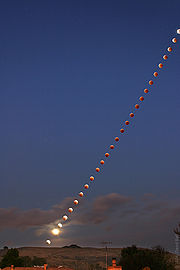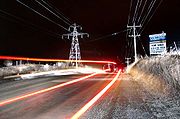
Multiple exposure
Encyclopedia

Photography
Photography is the art, science and practice of creating durable images by recording light or other electromagnetic radiation, either electronically by means of an image sensor or chemically by means of a light-sensitive material such as photographic film...
, a multiple exposure is the superimposition of two or more individual exposures to create a single photograph. The exposure values may or may not be identical to each other.
Overview
Ordinarily, cameras have a sensitivity to light that is a function of time. For example, a one second exposure is an exposure in which the camera image is equally responsive to light over the exposure time of one second. The criterion for determining that something is a double exposure is that the sensitivity goes up and then back down. The simplest example of a multiple exposure is a double exposure without flash, i.e. two partial exposures are made and then combined into one complete exposure.Some single exposures, such as "flash and blur" use a combination of electronic flash and ambient exposure. This effect can be approximated by a Dirac delta measure (flash) and a constant finite rectangular window, in combination. For example, a sensitivity window comprising a Dirac comb
Dirac comb
In mathematics, a Dirac comb is a periodic Schwartz distribution constructed from Dirac delta functions...
combined with a rectangular pulse, is considered a multiple exposure, even though the sensitivity never goes to zero during the exposure.
Analogue
In filmFilm
A film, also called a movie or motion picture, is a series of still or moving images. It is produced by recording photographic images with cameras, or by creating images using animation techniques or visual effects...
and photography
Photography
Photography is the art, science and practice of creating durable images by recording light or other electromagnetic radiation, either electronically by means of an image sensor or chemically by means of a light-sensitive material such as photographic film...
, double exposure is a technique in which a piece of film is exposed
Exposure (photography)
In photography, exposure is the total amount of light allowed to fall on the photographic medium during the process of taking a photograph. Exposure is measured in lux seconds, and can be computed from exposure value and scene luminance over a specified area.In photographic jargon, an exposure...
twice, to two different images. The resulting photographic image shows the second image superimposed over the first. The technique can be used to create ghostly images or to add people and objects to a scene that were not originally there. It is frequently used in photographic hoax
Hoax
A hoax is a deliberately fabricated falsehood made to masquerade as truth. It is distinguishable from errors in observation or judgment, or rumors, urban legends, pseudosciences or April Fools' Day events that are passed along in good faith by believers or as jokes.-Definition:The British...
es. It also is sometimes used as an artistic visual effect, especially when filming singers or musicians.
It is considered easiest to have a manual winding camera for double exposures. On automatic winding cameras, as soon as a picture is taken the film is typically wound to the next frame. Some more advanced automatic winding cameras have the option for multiple exposures but it must be set before making each exposure. Manual winding cameras with a multiple exposure feature can be set to double-expose after making the first exposure.
Since shooting multiple exposures will expose the same frame multiple times, negative exposure compensation
Exposure compensation
Exposure compensation is a technique for adjusting the exposure indicated by a photographic exposure meter, in consideration of factors that may cause the indicated exposure to result in a less-than-optimal image. Factors considered may include unusual lighting distribution, variations within a...
must first be set to avoid overexposure. For example, to expose the frame twice with correct exposure, a −1 EV compensation have to be done, and −2 EV for exposing four times. This may not be necessary when photographing a lit subject in two (or more) different positions against a perfectly dark background, as the background area will be essentially unexposed.
Medium to low light is ideal for double exposures. A tripod may not be necessary if combining different scenes in one shot. In some conditions, for example, recording the whole progress of a lunar eclipse in multiple exposures, a stable tripod is essential.
More than two exposures can be combined, with care not to overexpose the film.
Digital
Digital photographs can be superimposed by using a software photo editor such as Adobe PhotoshopAdobe Photoshop
Adobe Photoshop is a graphics editing program developed and published by Adobe Systems Incorporated.Adobe's 2003 "Creative Suite" rebranding led to Adobe Photoshop 8's renaming to Adobe Photoshop CS. Thus, Adobe Photoshop CS5 is the 12th major release of Adobe Photoshop...
or GIMP
GIMP
GIMP is a free software raster graphics editor. It is primarily employed as an image retouching and editing tool and is freely available in versions tailored for most popular operating systems including Microsoft Windows, Apple Mac OS X, and Linux.In addition to detailed image retouching and...
, by altering the opacity of the two images and line them up over each other, or set the layers to multiply mode, which 'adds' the colors together rather than making the colors of either image pale and translucent.
Examples in art, movies and television

- On the Ed Sullivan Show, this effect was sometimes used with singers and rock groups. An image of the stage set was superimposed on the performer(s).
- In the movie Mary Poppins, when Julie Andrews is singing "Feed the Birds" to the children, there's an instrumental section of the song. During this section, an image of St. Paul's Cathedral is superimposed on Julie Andrews' face.
- On the 1960s situation comedy The Dick Van Dyke Show, there's a special Christmas episode called "The Alan Brady Show Presents". On that episode, the double exposure effect is used on Larry MathewsLarry MathewsThis article is about the actor Larry Mathews from the USA. If you are looking for the Irish musician, please visit Larry Mathews .Larry Mathews was born in Burbank, California, on...
(who played Dick Van Dyke and Mary Tyler Moore's cute young son, Ritchie). He's singing the Christmas song "Little Drummer Boy", and at one point, an image of the stage set (a stained glass window) is superimposed on his face.
- On a current commercial for Fruit of the Loom underwear, this effect is used. In this commercial, the "Fruit of the Loom" men are a pop music group (with the "Apple" as the lead singer), and they're performing a ballad about a little boy who loves his "Fruit of the Loom" underwear.
- At the beginning of an episode of the popular '70's action series Wonder Woman, the double exposure effect is used on Lynda Carter (Wonder Woman). An outer-space style background (i.e. black sky, stars and lights) is superimposed on an image of her face and shoulders.
- From 1970 until 1985 fine artist, Ian HornakIan HornakIan Hornak was an American draughtsman, painter and printmaker associated with the Hyperrealist and Photorealist art movements.-Biography:...
created a series of 'multiple exposure landscape paintings'. The artist would capture multiple exposure photographs and then project them onto canvas. While the image was projected, he would sketch it with pencil and finally execute the painting using acrylic paint.
C.E.M.E.N.T.
With electronic imaging, long duration sensitivity is not practical, so multiple exposures are usually made using CEMENT (Computer Enhanced Multiple Exposure Numerical Technique). This simulates the effect of multiple exposures numerically, by using a computer, or computation.The use of CEMENT as a medium of artistic expression dates back to the 1970s and early 1980s with the invention of the wearable computer as a tool for visual artists.
Long exposures

Scanning film with multiple exposure
Multiple exposure technique can also be used when scanning transparencies like slides, film or negatives using a film scannerFilm scanner
A film scanner is a device made for scanning photographic film directly into a computer without the use of any intermediate printmaking. It provides several benefits over using a flatbed scanner to scan in a print of any size: the photographer has direct control over cropping and aspect ratio from...
for increasing dynamic range
Wide dynamic range
The wide dynamic range function of a camera is intended to provide clear images even under back light circumstances where intensity of illumination can vary excessively, namely when there are both very bright and very dark areas simultaneously in the field of view of the camera.WDR enables the...
. With multiple exposure the original gets scanned several times with different exposure intensities. An overexposed scan lights the shadow areas of the image and enables the scanner to capture more image information here. In contrary an underexposed scans allows to gather more details in the light areas. Afterwards the data can be calculated into a single HDR image with increased dynamic range.
Among the scanning software solutions which implement multiple exposure are VueScan and SilverFast
SilverFast
SilverFast is software for scanning and image processing, including photos, documents and slides, developed by LaserSoft Imaging.- History :...
.
See also
- Wide dynamic rangeWide dynamic rangeThe wide dynamic range function of a camera is intended to provide clear images even under back light circumstances where intensity of illumination can vary excessively, namely when there are both very bright and very dark areas simultaneously in the field of view of the camera.WDR enables the...
- High dynamic range imagingHigh dynamic range imagingIn image processing, computer graphics, and photography, high dynamic range imaging is a set of techniques that allows a greater dynamic range between the lightest and darkest areas of an image than current standard digital imaging techniques or photographic methods...
- BracketingBracketingIn photography, bracketing is the general technique of taking several shots of the same subject using different or the same camera settings. Bracketing is useful and often recommended in situations that make it difficult to obtain a satisfactory image with a single shot, especially when a small...
- AutobracketingAutobracketingAutobracketing is a feature of some more advanced cameras, whether film or digital cameras, particularly single-lens reflex cameras, where the camera will take several successive shots with slightly different settings. Later, the best-looking pictures can be picked from the batch...

